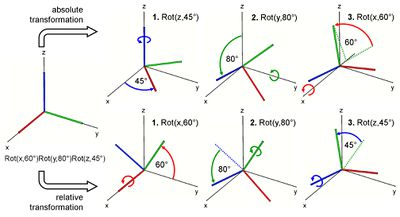Three-Angle Representations
To describe the orientation of an object in three-dimensional space, three angles are necessary. But depending on different approaches of applying multiple transformations there are different ways to define these three angles.
As previously described in the article about combinations of transformations, premultiplication of several transformations is usually used, which is called absolute transformation. This means, that transformations are executed from right to left and with respect to the static reference frame. This approach is shown in the upper row of the figure on the right. Three rotations Rot(x,60°), Rot(y,80°) and Rot(z,45°) should be applied to a coordinate frame located in the origin of a reference frame, so first the coordinate frame is rotated around the reference z-axis, then around the reference y-axis and finally around the reference x-axis.
Another approach to apply several transformations uses postmultiplication, the so called relative transformation. This means, that the transformations are executed from left to right, but in this case always with respect to the new frame. As can be seen in the lower row, the coordinate frame is first rotated around its x-axis, then around its new y-axis and finally around its current z-axis. When a whole transformation from the origin of the reference frame is considered, absolute and relative transformation lead to the same result. This can exemplarily be seen when you compare the two final coordinate frames on the right side of the figure.
In this regard, the yaw, pitch and roll-angles (RPY) are defined. In this convention three rotations around all the three reference coordinate axes x, y and z are applied.
